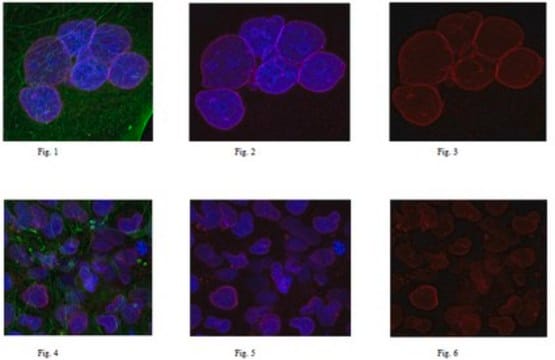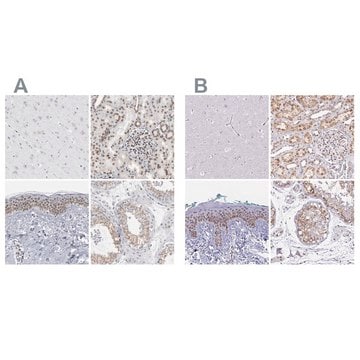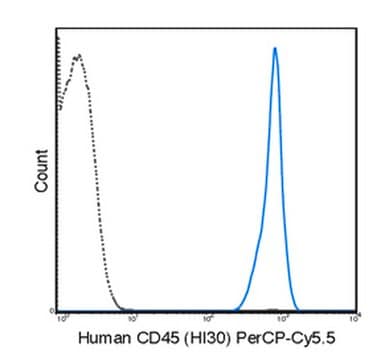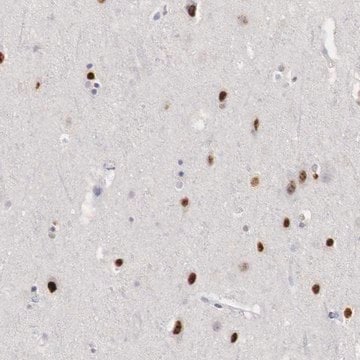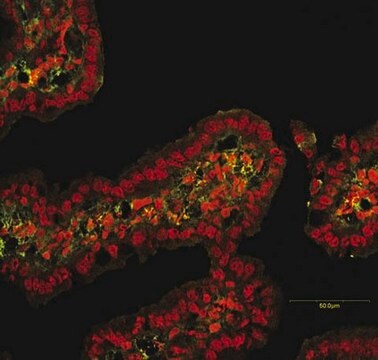MABN857
Anti-SYNE1 Antibody, clone 200A6
clone 200A6, from mouse
Sinonimo/i:
CPG2, Enaptin, Enaptin-165, Nesprin-1 Giant, Syne-1B
About This Item
Prodotti consigliati
Origine biologica
mouse
Livello qualitativo
Forma dell’anticorpo
purified immunoglobulin
Tipo di anticorpo
primary antibodies
Clone
200A6, monoclonal
Reattività contro le specie
rat
Reattività contro le specie (prevista in base all’omologia)
mouse (based on 100% sequence homology)
tecniche
electron microscopy: suitable
immunocytochemistry: suitable
western blot: suitable
Isotipo
IgG1κ
N° accesso Genebanck
N° accesso NCBI
Condizioni di spedizione
ambient
modifica post-traduzionali bersaglio
unmodified
Informazioni sul gene
mouse ... Syne1(64009)
Descrizione generale
Specificità
Immunogeno
Applicazioni
Electron Microscopy Analysis: A representative lot localized SYNE1 isoform CPG2 immunoreactivity colocalized with clathrin in the postsynaptic endocytic zone by immunoEM labeling of 60 nm thick serial sections of 4% paraformaldehyde-/0.1% glutaraldehyde-fixed rat neurons (Cottrell, J.R., et al. (2004). Neuron. 44(4):677-690).
Immunocytochemistry Analysis: A representative lot immunolocalized SYNE1 spliced isoform CPG2 on the dendritic spines, colocalized with clathrin, but segregated from the PSD and actin filaments in the spine head, by fluorescent immunocytochemistry staining of 4% formaldehyde-fixed, 0.3% Triton X-100-permeabilized rat hippocampal neurons. Target staining was greatly diminished among neurons received cellular CPG2 shRNA delivery (Cottrell, J.R., et al. (2004). Neuron. 44(4):677-690).
Western Blotting Analysis: A representative lot detected SYNE1 spliced isoform CPG2 as a ~110 kDa boublet band in rat cerebral cortex tissue extract and lysate from isolated rat cortical neurons. Target band detection was greatly diminished when using lysate from neurons following cellular CPG2 shRNA delivery (Cottrell, J.R., et al. (2004). Neuron. 44(4):677-690).
Neuroscience
Qualità
Western Blotting Analysis: 4 µg/mL of this antibody detected the ~110 kDa SYNE1 spliced isoform CPG2 in 10 µg of rat hippocampus tissue lysate.
Descrizione del bersaglio
Stato fisico
Stoccaggio e stabilità
Altre note
Note legali
Esclusione di responsabilità
Not finding the right product?
Try our Motore di ricerca dei prodotti.
Codice della classe di stoccaggio
12 - Non Combustible Liquids
Classe di pericolosità dell'acqua (WGK)
WGK 1
Punto d’infiammabilità (°F)
Not applicable
Punto d’infiammabilità (°C)
Not applicable
Certificati d'analisi (COA)
Cerca il Certificati d'analisi (COA) digitando il numero di lotto/batch corrispondente. I numeri di lotto o di batch sono stampati sull'etichetta dei prodotti dopo la parola ‘Lotto’ o ‘Batch’.
Possiedi già questo prodotto?
I documenti relativi ai prodotti acquistati recentemente sono disponibili nell’Archivio dei documenti.
Il team dei nostri ricercatori vanta grande esperienza in tutte le aree della ricerca quali Life Science, scienza dei materiali, sintesi chimica, cromatografia, discipline analitiche, ecc..
Contatta l'Assistenza Tecnica.